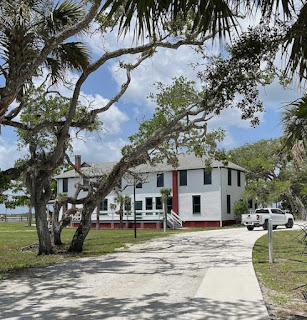 |
| Screengrab from travelfilmarchive YouTube channel's 1950 travelogue about Florida Credit: https://www.youtube.com/@travelfilmarchive |
Today's focus is a bit outside this blog's usual frontier parameters. But it's too classic to overlook: a 75-year-old travel film about Florida.
The 1950 black-and-white Let’s Look at Florida film is about a half-hour long. It's an episode in a series named Pageant of the States. I found it on the travelfilmarchive channel on YouTube. Watch it at https://www.youtube.com/watch?v=6BO33VEt-gM
Even in that pre-Disney era, the hype was thick. There wasn't a word about mosquitoes. No mention of hurricanes or humidity. Miami is described as having a median temperature of 75. Ha. I doubt that was true even in those pre-climate-change days.
More truthful and obvious was the glut of high-rise buildings already evident in Miami in 1950. The narrator said the city was growing faster than any other metro area in the United States.
I cringed at the treatment of animals at what passed for tourist attractions. Penned alligators were prodded and poked, pelicans had obviously had their wings clipped, and dolphins (and macaws and other birds) were trained to perform for humans. Yes, I realize we didn't know then what we do now about non-human species. But I wouldn't have liked it then, just as I don't now.
On a brighter note, I laughed at the clip showing crowded shuffleboard courts in St. Petersburg. The game was midcentury America's pickleball. It was also funny to hear that St. Petersburg, a city of 100,000 at the time, described as a "pensioner's paradise." And vintage car fans will delight in the now-classic vehicles that roll through many of the film's scenes.
In case anyone was worried, the narrator assured viewers that “Florida is still growing.” What an understatement. AI tells me the state's population in 1950 was about 2.7 million. We're at 23 million and climbing today.
I was intrigued by the numerous comments posted by viewers. Many were from people who grew up in that world - and who mentioned how hot the climate was. Most Floridians didn’t live in air-conditioned houses then. The residential air-conditioning boom was on the threshold, but it wasn't yet a thing in 1950. Yet these same commenters treasured their memories and felt a sense of loss for a world now gone.
Many years ago, I endured one year of Florida living in an apartment without air conditioning. A large, wood-frame 1890s house had been carved into apartments, which destroyed the air flow those old houses were known for. My two-room, second-floor apartment was brutally hot in summer even with a fan running on high in the window.
There are some people who say you aren’t really a Floridian until you’ve lived here a while without air conditioning. So, I qualify. Yet I will always be a hybrid Floridian-New Yorker with firmly attached Brooklyn roots. Just like I’ll always be a Sicilian-Slovenian-American.
I couldn’t find a person of color or non-WASPish ethnicity in the 1950 travelogue. A sign of the times, for sure. It reminds me to appreciate and learn about the past while embracing the good that progress has brought. And to sort through and call out the negatives that come along with them both.
















